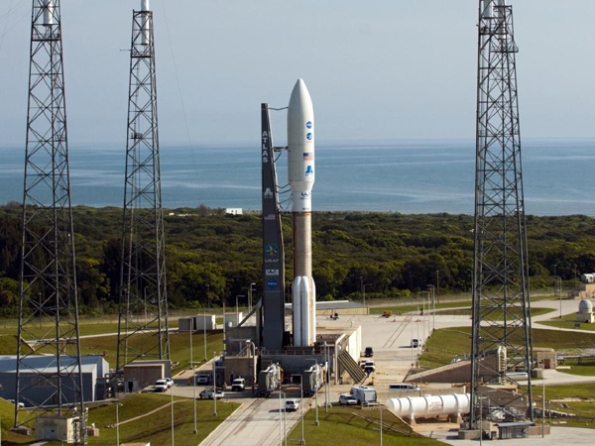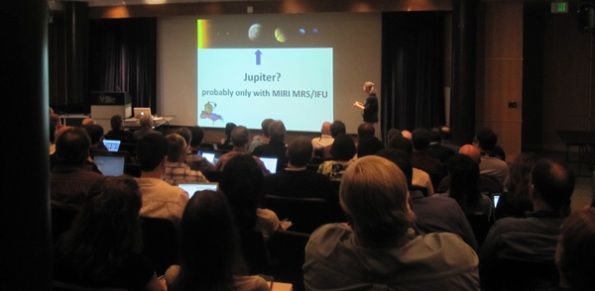Archive
Best Goddard Videos of 2011: Scientific Discoveries
On Friday this week, NASA/Goddard filmmakers, writers, and animators will screen what they consider their best work of 2011. It’s called the Best of Goddard Film Festival, and it’s held every year about this time for Goddard employees. (For employees, the festival will run from 10:30 am to 12:30 pm in the Goett Auditorium, Building 3.)
Even if you are “outside the Center,” you can still watch and enjoy the entries to the festival. They’ll run in groups this week on the blog.
The first group featured on the blog today focuses on NASA scientific discoveries from 2011. Which of these do you like best and why? Reply to the Geeked on Goddard comments section.
Terrestrial Gamma-ray Flashes
- Animators: Walt Feimer (HTSI) (Lead); Scott Wiessinger (UMBC); Joseph Dwyer (FIT); Chris Meaney (HTSI)
- Video Editor: Scott Wiessinger (UMBC)
- Narrator: Karen Fox (ASI)
- Producer: Scott Wiessinger (UMBC)
- Writers: Francis Reddy (SPSYS); Scott Wiessinger (UMBC)
Swift and Hubble Probe an Asteroid Crash
- Animators: Michael Lentz (UMBC) (Lead); Walt Feimer (HTSI); Scott Wiessinger (UMBC); Chris Smith (HTSI); Jake Dean (Aloe Design Studios); Chris Meaney (HTSI)
- Video Editor: Scott Wiessinger (UMBC)
- Narrator: Scott Wiessinger (UMBC)
- Producer: Scott Wiessinger (UMBC)
- Scientist: Dennis Bodewits (University of Maryland College Park)
- Writers: Francis Reddy (SPSYS); Scott Wiessinger (UMBC)
DNA Building Blocks Can Be Made in Space
- Animators: Chris Smith (HTSI) (Lead); Tyler Chase (UMBC)
- Video Editor: Chris Smith (HTSI)
- Interviewee: Michael P. Callahan (NASA/GSFC)
- Producer: Chris Smith (HTSI)
- Scientist: Michael P. Callahan (NASA/GSFC)
- Videographer: Ryan Fitzgibbons (USRA)
_____________________________________________________________________________________________________
OH AND DID I MENTION? All opinions and opinionlike objects in this blog are mine alone and NOT those of NASA or Goddard Space Flight Center. And while we’re at it, links to websites posted on this blog do not imply endorsement of those websites by NASA.
//
</p> <div><a href=”http://www.w3counter.com” mce_href=”http://www.w3counter.com”><img src=”https://www.w3counter.com/tracker.php?id=39986″ mce_src=”https://www.w3counter.com/tracker.php?id=39986″ style=”border: 0″ mce_style=”border: 0″ alt=”W3Counter” /></a></div> <p>
Watching the Juno launch at NASA Goddard
Here are more than 200 of us at NASA/Goddard watching the Juno Mission blast off to Jupiter. A team of our scientists and engineers built an instrument Juno will use to study Jupiter’s mighty magnetic field.
To learn all the amazing stuff Juno will do when it reaches Jupiter in 5 years, see the excellent and detailed web feature by my friend Liz Zubritsky.

_____________________________________________________________________________________________________
OH AND DID I MENTION? All opinions and opinionlike objects in this blog are mine alone and NOT those of NASA or Goddard Space Flight Center. And while we’re at it, links to websites posted on this blog do not imply endorsement of those websites by NASA.
//
&amp;amp;amp;lt;/p&amp;amp;amp;gt; &amp;amp;amp;lt;div&amp;amp;amp;gt;&amp;amp;amp;lt;a href=”http://www.w3counter.com” mce_href=”http://www.w3counter.com”&amp;amp;amp;gt;&amp;amp;amp;lt;img src=”https://www.w3counter.com/tracker.php?id=39986″ mce_src=”https://www.w3counter.com/tracker.php?id=39986″ style=”border: 0″ mce_style=”border: 0″ alt=”W3Counter” /&amp;amp;amp;gt;&amp;amp;amp;lt;/a&amp;amp;amp;gt;&amp;amp;amp;lt;/div&amp;amp;amp;gt; &amp;amp;amp;lt;p&amp;amp;amp;gt;
//
There goes the neighborhood: What will the Webb Telescope reveal about our solar system?

Astronomer Heidi Hammel talks about how the Webb Telescope can be used to study our solar system.
The James Webb Space Telescope will look far back in cosmic time to study the origins of the universe. But that doesn’t mean the observatory will turn a blind eye to the planets. Yesterday, at a conference at the Space Telescope Science Institute (STScI) in Baltimore, noted planetary astronomer Heidi Hammel gave us a quick tour of the solar system from Webb’s (future) point of view.
UPDATE: A webcast video of Hammel’s talk is now available on the STScI website.
The conference, Frontier Science Opportunities with the James Webb Space Telescope (June 6-8), is all about what Webb can and will do once it makes it into space. It’ll be a while: As Matt Mountain, director of STSciI, mentioned in his opening remarks to the conference, Webb won’t see the cold of space, some 1 million miles from Earth, until at least 2017.
Hammel is known to be a great speaker, and she didn’t disappoint. First she took Mercury, Venus, and Earth out of the lineup. Her Powerpoint slides?
Mercury? No.
Venus? No.
Earth? No.
Webb’s orbit and the size and shape of its sunshield leave these planets in an “exclusion zone” hidden from the observatory’s view. (Its planned orbital perch is a point called L2, opposite from Earth with respect to the sun.) Ok, fine. What about Mars?
Yes. According to a March 9, 2010 White Paper about Webb and the solar system, the observatory could measure a number of important things in Mars’ atmosphere, like dust and carbon dioxide gas, that affect its climate.
Hammel speculated that Webb’s infrared eyes could help solve the mysterious nature of methane releases observed on Mars. Where does the methane come from? Webb might help us figure it out.
Jupiter? Saturn? Yes, yes. There is much Webb could learn about the atmospheres of these giant gas planets — which are, by the way, the best nearby examples we have of the scores of giant gaseous exoplanets being discovered in other solar systems.
Titan, Saturn’s largest moon? Yes. Webb could add a decade of observations of Titan’s surface and atmosphere to the work of the Cassini orbiter, and during a time in Titan’s seasonal cycle not yet explored in the infrared band, according to the White Paper.
Uranus and Neptune? An enthusiastic thumbs up from Hammel to the idea of studying these cool, distant bodies with the Webb’s infrared camera and spectrographs. She cited several scientific puzzles that Webb might help solve, including shifts in the wavelengths of light emitted by Uranus as the planet rotates and Neptune’s inexplicably warm polar region.
In general, Hammel said, “Neptune’s atmosphere is so dynamic, and little is known.” Anything Webb contributes will be helpful.
Last but not least, the region beyond Neptune, realm of Pluto and the other icy dwarf planets, is also fair game for Webb. As the White Paper explains:
“Beyond Neptune, a class of cold, large bodies that include Pluto, Triton and Eris exhibits surface deposits of nitrogen, methane, and other molecules that are poorly observed from the ground, but for which JWST might provide spectral mapping at high sensitivity and spatial resolution difficult to match with the current generation of ground-based observatories.”
And comets, too. At least comets slow enough for Webb to track.
There has been much public hand wringing lately over growth in the Webb budget and slips in the launch date. But in the scientific community, two generations eagerly await the lofting of the giant Webb observatory into orbit. Many of them are up at STScI today sharing their plans.
“There’s a lot of great science that’s going to come out of this and I’m really looking forward to it,” Hammel said. “There is a wide range of interesting planetary phenomena observable by JWST, especially in the outer solar system.”
This NASA video goes into detail about planet studies — here and elsewhere in the universe — and the James Webb Space Telescope:
_____________________________________________________________________________________________________
OH AND DID I MENTION? All opinions and opinionlike objects in this blog are mine alone and NOT those of NASA or Goddard Space Flight Center. And while we’re at it, links to websites posted on this blog do not imply endorsement of those websites by NASA.
//
&amp;amp;amp;amp;amp;amp;amp;amp;amp;amp;amp;amp;amp;lt;/p&amp;amp;amp;amp;amp;amp;amp;amp;amp;amp;amp;amp;amp;gt; &amp;amp;amp;amp;amp;amp;amp;amp;amp;amp;amp;amp;amp;lt;div&amp;amp;amp;amp;amp;amp;amp;amp;amp;amp;amp;amp;amp;gt;&amp;amp;amp;amp;amp;amp;amp;amp;amp;amp;amp;amp;amp;lt;a href=”http://www.w3counter.com” mce_href=”http://www.w3counter.com”&amp;amp;amp;amp;amp;amp;amp;amp;amp;amp;amp;amp;amp;gt;&amp;amp;amp;amp;amp;amp;amp;amp;amp;amp;amp;amp;amp;lt;img src=”http://www.w3counter.com/tracker.php?id=39986″ mce_src=”http://www.w3counter.com/tracker.php?id=39986″ style=”border: 0″ mce_style=”border: 0″ alt=”W3Counter” /&amp;amp;amp;amp;amp;amp;amp;amp;amp;amp;amp;amp;amp;gt;&amp;amp;amp;amp;amp;amp;amp;amp;amp;amp;amp;amp;amp;lt;/a&amp;amp;amp;amp;amp;amp;amp;amp;amp;amp;amp;amp;amp;gt;&amp;amp;amp;amp;amp;amp;amp;amp;amp;amp;amp;amp;amp;lt;/div&amp;amp;amp;amp;amp;amp;amp;amp;amp;amp;amp;amp;amp;gt; &amp;amp;amp;amp;amp;amp;amp;amp;amp;amp;amp;amp;amp;lt;p&amp;amp;amp;amp;amp;amp;amp;amp;amp;amp;amp;amp;amp;gt;